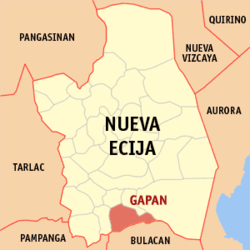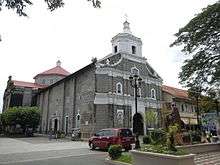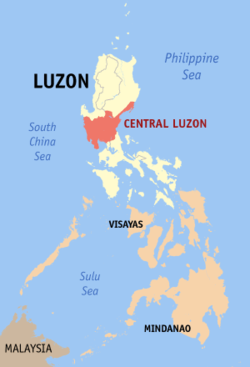Gapan
| Gapan | ||
|---|---|---|
| Component city | ||
|
Gapan, 2015 | ||
| ||
| Nickname(s): Tsinelas capital of the Philippines | ||
 Map of Nueva Ecija showing the location of Gapan City | ||
.svg.png) Gapan Location within the Philippines | ||
| Coordinates: 15°17′N 120°58′E / 15.283°N 120.967°ECoordinates: 15°17′N 120°58′E / 15.283°N 120.967°E | ||
| Country | Philippines | |
| Region | Central Luzon (Region III) | |
| Province | Nueva Ecija | |
| District | 4th District | |
| Founded | 1732 | |
| Cityhood | August 25, 2001 | |
| Barangays | 23 | |
| Government[1] | ||
| • Mayor | Emerson Pascual | |
| • Vice Mayor | Inocencio Bautista Jr.[2] | |
| • Representative | Megan Antonino Nadres (NUP) | |
| Area[3] | ||
| • Total | 164.44 km2 (63.49 sq mi) | |
| Population (2015)[4] | ||
| • Total | 110,303 | |
| • Density | 670/km2 (1,700/sq mi) | |
| Time zone | PHT (UTC+8) | |
| ZIP code | 3105 | |
| Dialing code | +63 (0)44 | |
| Income class | 4th class city | |
| Website |
www | |
Gapan known as Tsinelas capital of the Philippines is a fourth class city in the province of Nueva Ecija, Philippines. Gapan is nicknamed the "Footwear Capital of the North", and it is an inseparable part of the Rice Granary of the Philippines. According to the 2015 census, it has a population of 110,303 people.[4] It has a land area of 164.44 km².
Geography
Gapan is located in the southern part of the province. It is bounded to the north by Peñaranda and San Leonardo, to the east by the Gen. Tinio, to the south by San Miguel in neighboring Bulacan province, and to the west by San Isidro.
Barangays
Gapan is politically subdivided into 23 barangays.[3]
- Balante
- Bayanihan
- Bulak
- Bungo
- Kapalangan
- Mabuga
- Maburak
- Macabaklay
- Mahipon
- Malimba
- Mangino
- Marelo
- Pambuan
- Parcutela
- Puting Tubig
- San Lorenzo
- San Nicolas
- San Roque
- San Vicente
- Santa Cruz
- Santo Cristo Norte
- Santo Cristo Sur
- Santo Niño
History
Old records called the town Ibon. Gapan was founded by the Spanish curates and officials who, in their early occupation, exercised great influence over the people and the things they were doing. History places Gapan as one of the first towns of Pampanga founded sometime in the middle part of the sixteenth century. Records of the first Catholic mission to the far east indicated that in 1595, Fathers Contres Tendilla, Caballo and Salazar were responsible for clearing the forest which later became a pueblo. In this pueblo, a church, presedencia and residential houses made of bricks and lime were constructed, now the age-old landmarks of the city.
Its foundation in 1595 makes Gapan the oldest town in Nueva Ecija and one of the oldest in the Philippines. It was likewise a big pueblo embracing an area as far as Cabanatuan City in the north, which was its barrio with the name Cabanatuan before it separated in 1750: the Sierra Madres in the East, San Miguel, Bulacan in the south and Candaba, Pampanga in the West. Gradually as the Spanish power waned and economic progress caught up in the area, the pueblo disintegrated into many pueblos until it remained to comprise only the towns of Peñaranda, General Tinio and San Leonardo (formerly called Manikling) all of Nueva Ecija province. In fact the Patron Saint Divina Pastora had its origin or residence in Barrio Callos, Peñaranda.
In 1942, the occupation by the Japanese forces in Gapan, Nueva Ecija, In 1945, entering by the Filipino troops of the 2nd, 21st, 22nd, 23rd, 25th & 26th Infantry Division of the Philippine Commonwealth Army took Gapan together with the Novo Ecijano guerrilla resistance, Hukbalahap Communist rebel forces and the American liberation military forces of the United States Army at the end of World War II.
By virtue of Republic Act No. 9022 and its ratification in a plebiscite subsequently held on August 25, 2001, Gapan was converted into a component city of Nueva Ecija. Ernesto L. Natividad became the first city mayor of Gapan.
Liberation and the Battle of Gapan
After the Japanese air raid bombing and fighter planes invaded the town of Gapan on December 1941 during the Japanese Invasion through the occupation by the Imperial Japanese Army forces entered in Gapan on 1942 during the Japanese Occupation. When the aftermath of the retreated by all the local Novo Ecijaño guerrilla resistance and the Hukbalahap Communist guerrilla groups was the main invading commands was around side by side in the municipality of Gapan and attacking by all Imperial Japanese Army forces from the couple of few months and four years after the Counter-Insurgencies during the Japanese Occupation from 1942 to 1945 and before the main battle commands of all joint Filipino troops under the Philippine Commonwealth Army units and the American troops under the United States Army units was liberated in Gapan on 1945 during the fighting of main battle stages.
Beginning the Battle of Gapan on January to August 1945 during the Allied Liberation, the liberators of all combined military force of the Filipino troops under the Philippine Commonwealth Army 2nd, 21st, 22nd, 23rd, 25th & 26th Infantry Division and the American liberating soldiers of the United States Army was recaptured and invading to around the municipality of Gapan on January 1945 to aiding the local Novo Ecijaño guerrilla resistance and the Hukbalahap Communist guerrilla groups and attacked and defeating Japanese Imperial Army forces and Makapili rebel fighters.
From January to August 1945, the many stronghold of all combined military forces of the Filipino soldiers, military officers, tank commanders, military IFV's, military trucks and jeeps, artillery and mortars and many other military equipments under the 2nd, 21st, 22nd, 23rd, 25th & 26th Infantry Division of the Philippine Commonwealth Army and the American soldiers, military officers, tank commanders, military IFV's, military trucks and jeeps, artillery and mortars and many other military equipments under the United States Army was captured and invading the military battles, sieges and invading commands are bombed and destroyed around the plains, green fields, rice fields, rivers, forests and many others are burned and they captured and invading the battle, local military raids and invading commands are bombed and destroyed around the streets, old buildings and houses, villages, Roman Catholic churches, municipal town halls, town plazas and many others through aiding the local Novo Ecijaño guerrilla resistance and the Hukbalahap Communist guerrilla groups was side by side by attacked and defeating Japanese Imperial Army forces and Makapili militias from the couple of seven months and one year during the liberating battles, sieges, local military raids and invading the municipal town of Gapan during the liberation.
Start the joint and combined Allied military and guerrilla main sieges and invasions of the military field camps and garrisons of the Imperial Japanese Armed Forces and the Makapili headquarters in the municipal town of Gapan. The stronghold of all combined Filipino soldiers and officers under the Philippine Commonwealth Army units, the American soldiers of the United States Army units and local Novo Ecijano resistance groups was invaded and attacking sieges of the military field camps and garrisons of the Imperial Japanese Armed Forces and the headquarters of the Makapili was entering the camps and they inside to main attack and fought against the Japanese Imperial Army soldiers and Makapili rebels. The aftermath of the Allied Filipino and American sieges and invasions of the Imperial Japanese Armed Forces and Makapili militia groups in Gapan, the decisive successfully victories of all the stronghold the joint Filipino troops and officers of the Philippine Commonwealth Army units, the American soldiers of the United States Army units and local Novo Ecijano resistance fighters are saluted and captured and retaking the Japanese field camps and garrisons and the Makapili headquarters at the town municipalities after the fighting commands and surrendered and retreating Japanese troops and Makapili rebel forces.
Meanwhile, the re-taken and capturing of the Japanese military field camps and garrisons and the headquarters of the Makapili in Gapan was there inside by the joint military forces of the Filipino soldiers and officers under the Philippine Commonwealth Army units and the American soldiers of the United States Army units including the local Novo Ecijano guerrilla resistance was pole flag raising of down of the Japanese flag for the Imperial Japanese military through the capturing and taken the up of the joint United States flag and the Philippine war flag for the joint United States and Philippine Commonwealth military after the fighting of the siege and invading commands for the victorious of the stronghold combined Filipinos and Americans.
The Aftermath of the Battle of Gapan on August 1945, the local Philippine Commonwealth military and Novo Ecijano guerrilla resistance casualties during the fighting and succeeding battles, invasions and sieges includes of all Filipino troops and officers of the Philippine Commonwealth Army 2nd, 21st, 22nd, 23rd, 25th & 26th Infantry Division was over 4,470 killed in action and over 15,300 wounded in action, the American troops and officers of the United States Army was over 2,400 killed in action and over 6,000 wounded in action, while the local Novo Ecijano guerrilla resistance groups was suffered over 400 killed in action and over 1,140 wounded in action, the Hukbalahap Communist groups over 720 killed in action and over 1,350 wounded in action. From the part of Japanese Imperial Army forces over 25,000 killed in action, 58,000 wounded in action and over 14,000 captured in action, the Makapili militia groups over 400 killed in action, 670 wounded in action and over 1,260 captured in action. The joint Filipino soldiers and officers under the Philippine Commonwealth Army units and the American soldiers and officers of the United States Army units include with the local Novo Ecijano and Hukbalahap Communist resistance fighters to saluted on their decisive successfully victories after the invasions, sieges and battle main commands as they captured the municipal town of Gapan after the war.
Demographics
| Population census of Gapan City | ||
|---|---|---|
| Year | Pop. | ±% p.a. |
| 1990 | 70,489 | — |
| 1995 | 77,735 | +1.85% |
| 2000 | 89,199 | +2.99% |
| 2007 | 98,795 | +1.42% |
| 2010 | 101,488 | +0.98% |
| 2015 | 110,303 | +1.60% |
| Source: National Statistics Office[4][5] | ||
Economy
Current major sources of income include farming, slipper making, fishponds, poultry and piggery, and commercial establishments.
The city of Gapan held tremendous promise not only in its natural resources but also in its potentials in agri base industries and in footwear industries which help sustain its virtual role in agricultural and industrial production. Commercial and trade activities in the city are further accelerated by the influx of financing lending institution and new businesses.
Shopping Centers and Supermarkets
- Fiesta Shopping Center
- Puregold
- Unitop Gapan
- Waltermart Gapan
Places of interest

- National Shrine of Virgen La Divina Pastora
- The center of Marian pilgrimages during the months of April and May is the National Shrine of Virgen La Divina Pastora as declared by the Catholic Bishops Conference in 1986.
Colleges in Gapan City
- Divina Pastora College
- Asian Institute of E-commerce (AIE) - Gapan Campus
- Gapan Computer Technical Institute
- ACLC College (Gapan Campus)
- Allen Institute of Technology
- College for Research and Technology
- Nueva Ecija University of Science and Technology – Gapan Academic Extension Campus
- Gapan City Technical School
- Provincial Manpower Training Center (Technical School)
- SKD Academy Gapan Campus
Notable people of Gapan
- Mariano Llanera, the Revolutionary General of the battle Cry of Nueva Ecija in Cabiao, Nueva Ecija.
- General Pantaleon Valmonte, the capitan municipal of Gapan who, together with General Mariano Llanera, capitan municipal of Cabiao, launched the "First Cry of Nueva Ecija" against the Spanish rule on September 2, 1896.
- Juan Liwag - former Senator of the Philippines
- Nida Blanca - award winning actress
- Liza Soberano - Hope Elizabeth Soberano (formerly known by the screen name Hope Soberano), a young Filipina American model and actress, is a contract artist of ABS-CBN and Star Magic. Her great grandparents Isabel Jacinto Arevalo and Olympia Alnas Padilla were from Gapan and from Carranglan.
- Eula Valdez - veteran Filipina actress
- Ryza Cenon - Filipina actress
- Joe Taruc - news anchor currently working at DZRH in the Philippines
- Jay Taruc - news anchor at GMA Network
Images
- Rice fields, Sto. Cristo
- City Hall
- City park
 Wet market
Wet market- Dry Market and the Water District
- Cockfighting Coliseum
References
- ↑ "Official City/Municipal 2013 Election Results". Intramuros, Manila, Philippines: Commission on Elections (COMELEC). 11 September 2013. Retrieved 21 October 2013.
- ↑ http://www.pcoo.gov.ph/dir-lgu-citymayors.htm
- 1 2 "Province: Nueva Ecija". PSGC Interactive. Makati City, Philippines: National Statistical Coordination Board. Retrieved 21 October 2013.
- 1 2 3 "Total Population by Province, City, Municipality and Barangay: as of May 1, 2010" (PDF). 2010 Census of Population and Housing. National Statistics Office. Retrieved 2012-10-19.
- ↑ "Province of Nueva Ecija". Municipality Population Data. LWUA Research Division. Retrieved 21 October 2013.
External links
| Wikimedia Commons has media related to Gapan City. |
- Gapan City Official Website
- Pasyalan Nueva Ecija
- Philippine Standard Geographic Code
- Philippine Census Information
- Local Governance Performance Management System
 |
San Leonardo / Peñaranda |  | ||
| San Isidro | |
General Tinio | ||
| ||||
| | ||||
| San Miguel, Bulacan | Doña Remedios Trinidad, Bulacan |

